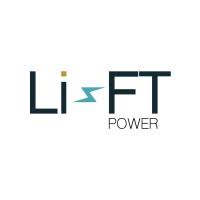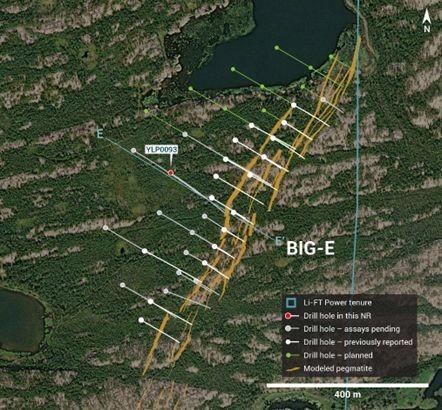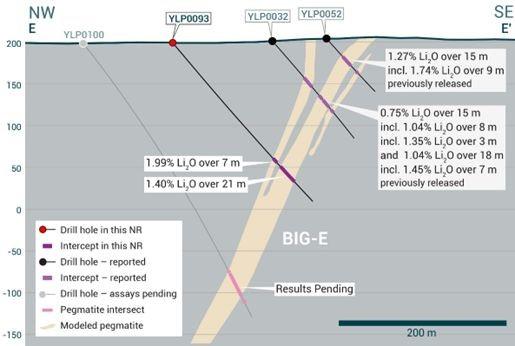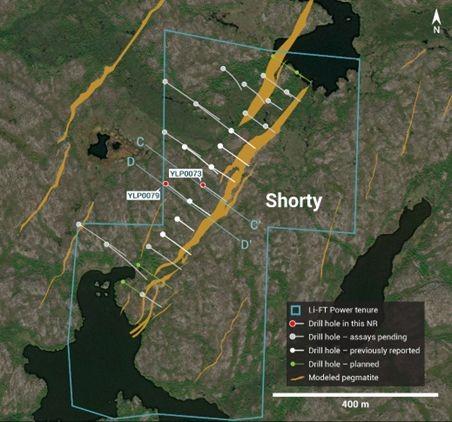
LIFT Intersects 21 m at 1.40% Li2O at the BIG East pegmatite and 19 m at 1.16% Li2O at the Shorty pegmatite, Yellowknife Lithium Project, NWT
Li-FT Power Ltd. (TSX-V: LIFT) (OTCQX: LIFFF) (Frankfurt: WS0) is pleased to report assays from 5 drill holes completed at the BIG East, Shorty, Ki and Fi Southwest pegmatites within the Yellowknife Lithium Project located outside the city of Yellowknife, Northwest Territories (Figure 1). Drilling has intersected significant intervals of spodumene mineralization, with the following highlights:
Highlights:
- YLP-0093: 21 m at 1.40% Li2O, (BIG East)
and: 7 m at 1.99% Li2O - YLP-0073: 19 m at 1.16% Li2O, (Shorty)
- YLP-0072: 17 m at 0.79% Li2O, (Ki)
including: 6 m at 1.11% Li2O
and including: 5 m at 1.03% Li2O - YLP-0079: 10 m at 1.36% Li2O, (Shorty)
and: 4 m at 1.07% Li2O
and: 1 m at 1.42% Li2O - YLP-0075: 10 m at 1.33% Li2O, (Fi-Southwest)
and: 4 m at 1.29% Li2O
Discussion of Results
This week’s drill results are for five holes from four different pegmatite dykes, including BIG East (YLP-0093), Shorty (YLP-0073, 79), Ki (YLP-0072), and Fi Southwest (YLP-0075). A table of composite calculations, some general comments related to this discussion, and a table of collar headers are provided towards the end of this section.
Figure 1 – Location of LIFT’s Yellowknife Lithium Project. Drilling is focused on the Road Access Group of pegmatites which are located to the east of the city of Yellowknife along a government-maintained paved highway, as well as the Echo target in the Further Afield Group.
BIG East Pegmatite
The BIG East pegmatite swarm comprises a 35-80 m wide corridor of parallel-trending dykes that dips around 55°-75° west and extends for at least 1,100 m along surface and 200 m downdip.
YLP-0093 was designed to test the BIG East swarm approximately 500 m from its northern end and 150 vertical m beneath the surface. Drilling intersected two pegmatite dykes over 38 m of core length that are, respectively, 7 m and 25 m in width. Assays returned 1.99% Li2O over 7 m from the upper dyke and 1.40% Li2O over 21 m from the lower one (Table 1 and 2, Figures 2 and 3).
Figure 2 – Plan view showing the surface expression of the BIG-East pegmatite with diamond drill holes reported in this press release.
Figure 3 – Cross-section of YLP-0093 which intersected the BIG-East pegmatite dyke with a 21 m interval of 1.40% Li2O.
Shorty Pegmatite
The Shorty pegmatite is one of several dykes within a broader north-of-northeast striking corridor. The Shorty pegmatite itself is a braided zone of dykes that dips 50°-70° to the west-northwest and extends for at least 700 m on surface and 200 m downdip. LIFT drilling shows that Shorty may comprise a single dyke up to 25 m wide or 2-4 dykes, mostly 1-15 m wide, over 30-40 m of core length.
YLP-0073 was designed to test the Shorty dyke approximately 350 m from its southern end and 50 m vertically beneath the surface. Drilling intersected a single, 25 m wide, pegmatite dyke that returned an assay composite of 1.16% Li2O over 19 m.
YLP-0079 was collared 100 m due west of YLP-0073 to test the Shorty pegmatite approximately 300 m from its southern end and 125 m vertically beneath the surface. Drilling intersected four pegmatite dykes over 39 m of core length, comprising a central 18 m wide pegmatite flanked by three 2-5 m wide dykes. The central pegmatite returned an assay composite of 1.36% Li2O over 10 m whereas the two lower flanking dykes returned 1.42% Li2O over 1 m and 1.07% Li2O over 4 m. The upper flanking dyke returned negligible grade (Table 1 and 2, Figures 4, 5, and 6).
Figure 4 – Plan view showing the surface expression of the Shorty pegmatite with diamond drill holes reported in this press release.
Figure 5 – Cross-section illustrating YLP-0073 with results as shown in the Shorty pegmatite dyke with a 19 m interval of 1.16% Li2O.
Figure 6 – Cross-section illustrating YLP-0079 with results as shown in the Shorty pegmatite dyke with a 10 m interval of 1.36% Li2O.
Ki Pegmatite
The Ki pegmatite is one of several dykes occurring within a broader north-of-northwest striking corridor. The Ki dyke itself extends for approximately 1,000 m on surface and at least 100 m downdip, is around 20 m thick, and dips between 65°-80° to the southwest. Typically, the so-called main dyke is flanked by one or more narrower (1-5 m wide) dykes.
YLP-0072 was drilled to test the Ki dyke approximately 250 m from its northern end and 25 vertical m below the surface. The main Ki dyke extends from 11 to 30 m core depth and is split by a 5 m panel consisting mostly of wall rock. Thinner (1-4 m wide) pegmatite intervals occur within this panel, immediately above the main dyke, and 90 m further down the drill hole. Assays from the main dyke returned 0.79% Li2O over 17 m and includes subintervals of 1.03% Li2O over 5 m and 1.11% Li2O over 6 m. All the 1-4 m intervals returned negligible grades (Table 1 and 2, Figures 7 and 8).
Figure 7 – Plan view showing the surface expression of the Ki pegmatite with diamond drill holes reported in this press release.
Figure 8 – Cross-section illustrating YLP-0072 with results as shown in the Ki pegmatite dyke with a 17 m interval of 0.79% Li2O.
Fi Southwest Pegmatite
The Fi Southwest (SW) pegmatite is one of several occurring within a broader north-of-northeast striking dyke corridor. The Fi-SW dyke itself is 25-30 m wide, dips 60°-80° to the east-southeast and extends for at least 1,100 m on surface and 200 m downdip.
YLP-0075 was drilled to test the Fi-SW pegmatite just 50 m from its northern end and 150 m vertically below the surface. Drilling intersected 11 m and 13 m wide pegmatite dykes separated from each other by a 21 m interval that includes a 3 m wide pegmatite intercept. Assay composites include 1.29% Li2O over 4 m for the uppermost dyke and 1.33% Li2O over 10 m for the lowermost, with the 3 m wide central dyke returning negligible grade (Table 1 and 2, Figures 9 and 10).
Figure 9 – Plan view showing the surface expression of the Fi-SW pegmatite with diamond drill holes reported in this press release.
Figure 10 – Cross-section illustrating YLP-0075 with results as shown in the Fi-SW pegmatite dyke with a 10 m interval of 1.33% Li2O.
Drilling Progress Update
Currently, LIFT has reported results from 77 diamond drill holes (13,570 m). To date, 198 diamond drill holes have been completed (34,238 m).
Table 1 – Assay highlights for drill holes reported in this press release.
| Hole No. | From (m) | To (m) | Interval (m) | Li2O% | Dyke |
| YLP0072 | 12 | 29 | 17 | 0.79 | Ki |
| Including | 12 | 17 | 5 | 1.03 | Ki |
| And including | 23 | 29 | 6 | 1.11 | Ki |
| YLP0073 | 51 | 70 | 19 | 1.16 | SHORTY |
| YLP0075 | 157 | 161 | 4 | 1.29 | Fi-SW |
| 186 | 196 | 10 | 1.33 | Fi-SW | |
| YLP0079 and and |
132 | 142 | 10 | 1.36 | SHORTY |
| 146 | 147 | 1 | 1.42 | SHORTY | |
| 150 | 154 | 4 | 1.07 | SHORTY | |
| YLP0093 | 184 | 191 | 7 | 1.99 | BIG EAST |
| 198 | 219 | 21 | 1.40 | BIG EAST |
General Statements
All five holes described in this news release were drilled broadly perpendicular to the dyke orientation so that the true thickness of reported intercepts will range somewhere between 65-100% of the drilled widths. A collar header table is provided below.
Mineralogical characterization for the YLP pegmatites is in progress through hyper spectral core scanning and X-ray diffraction work. Visual core logging indicates that the predominant host mineral is spodumene whereas other significant non-lithium bearing phases include quartz and feldspar.
Table 2 – Drill collars table of reported drill holes in this press release
| Drill Hole | Easting | Northing | Elevation (m) | Azimuth (°) | Dip (°) | Depth (m) | Dyke |
| YLP0072 | 373,068 | 6,942,888 | 257 | 57 | 45 | 172 | Ki |
| YLP0073 | 372,817 | 6,938,049 | 255 | 123 | 45 | 101 | SHORTY |
| YLP0075 | 371,564 | 6,941,035 | 249 | 295 | 50 | 243 | Fi-SW |
| YLP0079 | 372,727 | 6,938,053 | 255 | 125 | 65 | 171 | SHORTY |
| YLP0093 | 345,904 | 6,933,129 | 205 | 121 | 50 | 254 | BIG EAST |
QA/QC and Core Sampling Protocols
All drill core samples were collected under the supervision of LIFT employees and contractors. Drill core was transported from the drill platform to the core processing facility where it was logged, photographed, and split by diamond saw prior to being sampled. Samples were then bagged, and blanks and certified reference materials were inserted at regular intervals. Field duplicates consisting of quarter-cut core samples were also included in the sample runs. Groups of samples were placed in large bags, sealed with numbered tags in order to maintain a chain-of-custody, and transported from LIFT’s core logging facility to ALS Labs (“ALS”) laboratory in Yellowknife, Northwest Territories.
Sample preparation and analytical work for this drill program were carried out by ALS. Samples were prepared for analysis according to ALS method CRU31: individual samples were crushed to 70% passing through 2 mm (10 mesh) screen; a 1,000-gram sub-sample was riffle split (SPL-21) and then pulverized (PUL-32) such that 85% passed through 75-micron (200 mesh) screen. A 0.2-gram sub-sample of the pulverized material was then dissolved in a sodium peroxide solution and analysed for lithium according to ALS method ME-ICP82b. Another 0.2-gram sub-sample of the pulverized material was analysed for 53 elements according to ALS method ME-MS89L. All results passed the QA/QC screening at the lab, all inserted standards and blanks returned results that were within acceptable limits.
Qualified Person
The disclosure in this news release of scientific and technical information regarding LIFT’s mineral properties has been reviewed and approved by Ron Voordouw, Ph.D., P.Geo., Partner, Director Geoscience, Equity Exploration Consultants Ltd., and a Qualified Person as defined by National Instrument 43-101 Standards of Disclosure for Mineral Projects (NI 43-101) and member in good standing with the Northwest Territories and Nunavut Association of Professional Engineers and Geoscientists (NAPEG) (Geologist Registration number: L5245).
About LIFT
LIFT is a mineral exploration company engaged in the acquisition, exploration, and development of lithium pegmatite projects located in Canada. The Company’s flagship project is the Yellowknife Lithium Project located in Northwest Territories, Canada. LIFT also holds three early-stage exploration properties in Quebec, Canada with excellent potential for the discovery of buried lithium pegmatites, as well as the Cali Project in Northwest Territories within the Little Nahanni Pegmatite Group.
MORE or "UNCATEGORIZED"
Rocky Shore Identifies Higher Gold Grades Within Recently Acquired Gold Deposits at its Gold Anchor Project in Newfoundland
Rocky Shore Gold Ltd. (CSE: RSG) is pleased to announce that ongo... READ MORE
Near Surface Drilling Continues to Expand and Confirm Gold Mineralization
Red Pine Exploration Inc. (TSX-V: RPX) (OTCQB: RDEXF) is pleased ... READ MORE
Doubleview Gold Corp Extends Mineralization East of 2024 Conceptual Pit and Identifies Deeper Porphyry Indicators at Hat Project by Drilling 992m of 0.29% CuEq in Hole H101
Doubleview Gold Corp. (TSX-V: DBG) (OTCQB: DBLVF) (FSE: 1D4) is p... READ MORE
Newcore Gold Drilling Intersects 3.16 g/t Gold over 3.0 Metres from 62 Metres and 0.78 g/t Gold over 16.0 Metres from 16 Metres, at the Enchi Gold Project, Ghana
Drilling Intersects Near Surface Gold Mineralization at the Boin ... READ MORE
McEwen Secures Key Permit for El Gallo Mine; Mill Construction to Begin Mid-2026 - First Gold Pour Mid-2027
McEwen Inc. (NYSE:MUX) (TSX: MUX) is pleased to announce that th... READ MORE























